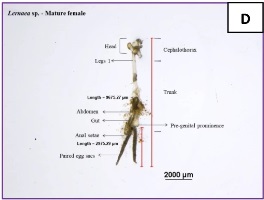Parasitic infestations and their control programmes are one among the challenges to be considered the most significant in aquaculture. A parasitic infestation was studied elaborately in Asian Seabass, Lates calcarifer juveniles with clinical signs, post-mortem findings, morphological and molecular identifications. In addition, those fish were also treated with emamectin benzoate (EMB) @ 50 µg kg−1 of fish body weight (BW) d−1 for 10 consecutive days under the controlled wet lab facility by feeding through the medicated feed at 4% BW. Results showed that the parasitic prevalence, parasitic intensity (PI) and mortality were 45.5%, 8.17 ± 0.15 per fish and 40% over a period of one week in that existing cage culture. The parasite was identified as a crustacean bloodsucker, anchor worm Lernaea sp. and EMB was found to be 100% effective with significant reduction in PI over a period of 10 days with improved survival rate of 90% against the untreated group. Infested but treated group revealed substantial haematological improvement in parameters such as RBC, WBC, Hb, PCV, large lymphocytes, small lymphocytes and total lymphocytes (P < 0.01). Similarly, comparative histopathology of vital organs also revealed no discernible lesions between the healthy and treated fish juvenile as compared to that of infested untreated group. Hence, EMB can be used to control the Lernaea sp. infestation in Asian Seabass.
Natural infestation of an anchor worm, Lernaea sp. in cage culture of Asian Seabass, Lates calcarifer juveniles and its control using an anti-parasitic drug, emamectin benzoate
